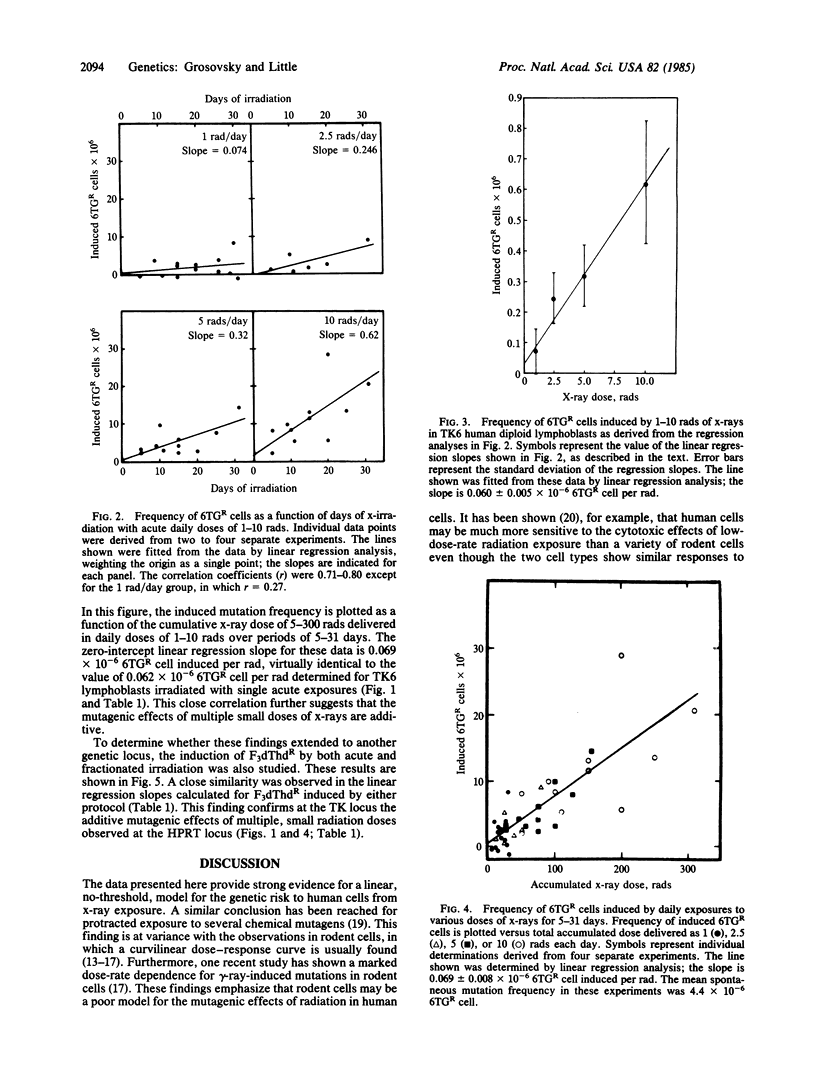Abstract
The induction of 6-thioguanine resistance (6TGR) was studied in continuous human lymphoblast cultures exposed to daily x-ray doses of 1, 2.5, 5, or 10 rads (1 rad = 0.01 gray) for periods up to 1 month. Samples were taken every 5 days for determinations of induced mutation frequency. Cells receiving daily doses of 1-10 rads showed a mutation frequency of 0.069 X 10(-6) 6TGR cell per rad, virtually identical to the value of 0.062 X 10(-6) 6TGR cell per rad determined for lymphoblasts receiving the same total dose of radiation in a single acute exposure. The effects of small daily fractions were additive, suggesting that doses as small as 1 rad are mutagenic in human lymphoblasts. Similar results were observed when resistance to trifluorothymidine, indicative of thymidine kinase deficiency, was used as a mutational marker. When 6TGR frequency was plotted against days of irradiation, a positive linear slope was observed for all dose groups. The values of these slopes were plotted against x-ray dose in rads/day to construct a dose-response relationship for 1-10 rads. A linear increase in mutation frequency was observed over this dose range, with no apparent threshold. The slope of this linear increase was 0.060 X 10(-6) 6TGR cell per rad. These results suggest that, for human lymphoblasts, the mutagenic risk of low doses of x-rays can be accurately estimated by linear extrapolation from high-dose effects.
Full text
PDF



Selected References
These references are in PubMed. This may not be the complete list of references from this article.
- Albertini R. J., DeMars R. Somatic cell mutation. Detection and quantification of x-ray-induced mutation in cultured, diploid human fibroblasts. Mutat Res. 1973 May;18(2):199–224. doi: 10.1016/0027-5107(73)90037-7. [DOI] [PubMed] [Google Scholar]
- Burki H. J. Ionizing radiation-induced 6-thioguanine-resistant clones in synchronous CHO cells. Radiat Res. 1980 Jan;81(1):76–84. [PubMed] [Google Scholar]
- Cox R., Masson W. K. X-ray-induced mutation to 6-thioguanine resistance in cultured human diploid fibroblasts. Mutat Res. 1976 Oct;37(1):125–136. doi: 10.1016/0027-5107(76)90060-9. [DOI] [PubMed] [Google Scholar]
- Fox M. Factors affecting the quantitation of dose-response curves for mutation induction in V79 Chinese hamster cells after exposure to chemical and physical mutagens. Mutat Res. 1975 Sep;29(3):449–466. doi: 10.1016/0027-5107(75)90064-0. [DOI] [PubMed] [Google Scholar]
- Jostes R. F., Bushnell K. M., Dewey W. C. X-ray induction of 8-azaguanine-resistant mutants in synchronous Chinese hamster ovary cells. Radiat Res. 1980 Jul;83(1):146–161. [PubMed] [Google Scholar]
- LeMotte P. K., Little J. B. A comparison of the lethal effects of intracellular radionuclides in human and rodent cells. Radiat Res. 1983 Aug;95(2):359–369. [PubMed] [Google Scholar]
- Liber H. L., LeMotte P. K., Little J. B. Toxicity and mutagenicity of X-rays and [125I]dUrd or [3H]TdR incorporated in the DNA of human lymphoblast cells. Mutat Res. 1983 Nov;111(3):387–404. doi: 10.1016/0027-5107(83)90035-0. [DOI] [PubMed] [Google Scholar]
- Liber H. L., Thilly W. G. Mutation assay at the thymidine kinase locus in diploid human lymphoblasts. Mutat Res. 1982 Jun;94(2):467–485. doi: 10.1016/0027-5107(82)90308-6. [DOI] [PubMed] [Google Scholar]
- Nakamura N., Okada S. Dose-rate effects of gamma-ray-induced mutations in cultured mammalian cells. Mutat Res. 1981 Aug;83(1):127–135. doi: 10.1016/0027-5107(81)90077-4. [DOI] [PubMed] [Google Scholar]
- Penman B. W., Crespi C. L., Komives E. A., Liber H. L., Thilly W. G. Mutation of human lymphoblasts exposed to low concentrations of chemical mutagens for long periods of time. Mutat Res. 1983 Mar;108(1-3):417–436. doi: 10.1016/0027-5107(83)90137-9. [DOI] [PubMed] [Google Scholar]
- RUSSELL W. L. X-ray-induced mutations in mice. Cold Spring Harb Symp Quant Biol. 1951;16:327–336. doi: 10.1101/sqb.1951.016.01.024. [DOI] [PubMed] [Google Scholar]
- Thacker J., Stretch A. Recovery from lethal and mutagenic damage during postirradiation holding and low-dose-rate irradiations of cultured hamster cells. Radiat Res. 1983 Nov;96(2):380–392. [PubMed] [Google Scholar]
- Van Zeeland A. A., Simons J. W. Linear dose--response relationships after prolonged expression times in V-79 Chinese hamster cells. Mutat Res. 1976 Apr;35(1):129–137. doi: 10.1016/0027-5107(76)90175-5. [DOI] [PubMed] [Google Scholar]
- de Ruijter Y. C., Simons J. W. Determination of the expression time and the dose--response relationship for mutations at the HGPRT (hypoxanthine-guanine-phosphophoribosyl transferase) locus induced by X-irradiation in human diploid skin fibroblasts. Mutat Res. 1980 Feb;69(2):325–332. doi: 10.1016/0027-5107(80)90097-4. [DOI] [PubMed] [Google Scholar]


